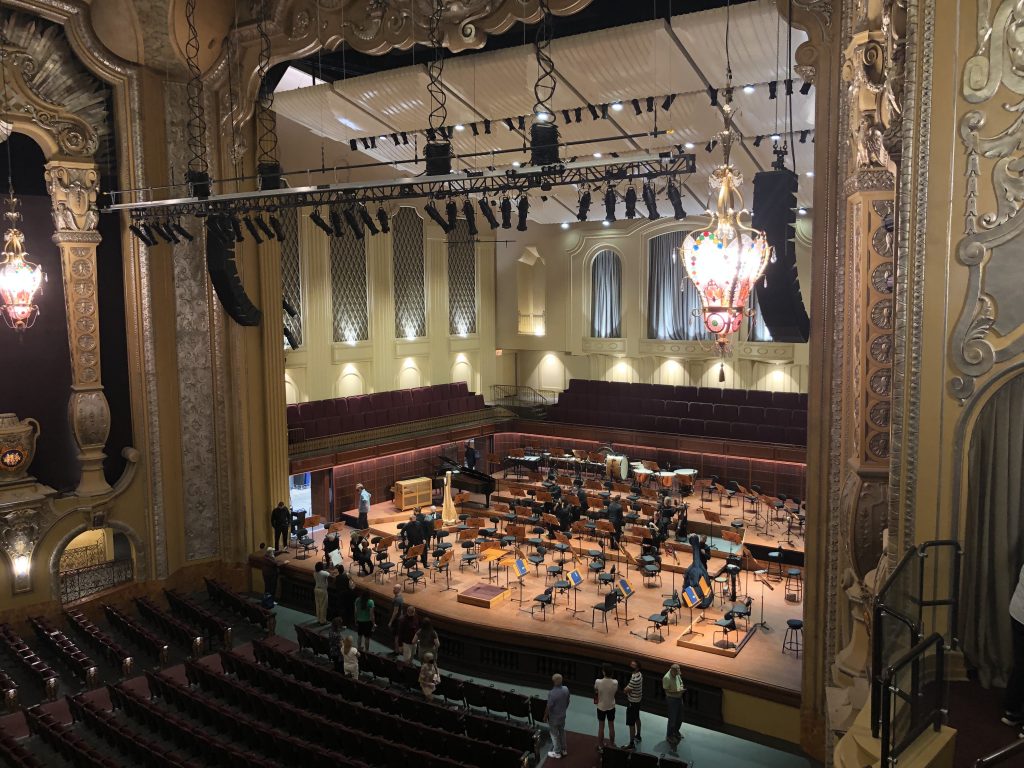Milwaukee Arts Groups in Big Trouble
Huge declines in the percent of earned income are a very worrisome sign.
Milwaukee has always prided itself on having a full complement of major arts groups: a symphony orchestra, repertory theater, ballet, opera company and art museum. But a recent study by the Wisconsin Policy Forum (WPF) shows that the major performing arts groups, along with smaller companies in Milwaukee, are in big trouble, with the percent of their budget coming from earned income — mostly paid admissions — plummeting over the past decade.
The decline for other Milwaukee performing arts groups in the 10-year period from 2012 to 2022 is also alarming: The Milwaukee Rep plummeted from 59% earned income to 31%; First Stage from 54% to 16%; the Skylight Music Theatre from 35% to 26%; and the Milwaukee Symphony Orchestra from 21% to 17%.
While the MSO declined the least, back in the 1990s it was earning 32% of its budget from earned income, which was then a bit higher than peer orchestras nationally. Moreover, the symphony’s move to its own hall was supposed to increase revenue. In fact, it did, and by quite a lot: the report notes that during the 2021-22 season – the first after the opening of the MSO’s $90 million Bradley Symphony Center – ticket sale revenue grew to $4.5 million, compared to $2.9 million in the last season before the pandemic hit. But operating expenses for the new symphony center “have grown, increasing the MSO’s annual operating budget by $4 million,” the WPF found. The net result is a decline in the percent of its total budget from ticket revenue.
| Performing Arts Group | Percent of 2022 Budget From Earned Income |
|---|---|
| Milwaukee Ballet | 40% |
| Milwaukee Rep | 31% |
| Skylight Music Theatre | 26% |
| Milwaukee Symphony Orchestra | 17% |
| First Stage | 16% |
| Florentine Opera Company | 6% |
The main bright spot in the report is the Milwaukee Ballet. Its earned income was 41% in the mid-1990s and that actually grew to about 48% in 2012 and then 51% in 2017, only to fall to 40% in 2022, the WPF found. Still, that shows the company earns about as much of its budget as it did 30 years ago, which is remarkable. Nationally ticket sales for dance companies declined by a whopping 33% from 2019 to 2022. The ballet is helped by revenue from its dance school, the report notes.
Among the smaller performing arts groups there were two doing relatively well. From 2012 to 2022 the percent of budget coming from earned income rose from 26% to 32% for the Bel Canto Chorus. And Danceworks was above 50% earned income in 2012 and 2017, though that dropped to 32% in 2022. Still, compared to most groups in town that’s pretty good, and probably also reflects dance school revenue.
“Overall, this analysis suggests a troubling story,” the WPF warns. “Program service revenue — including ticket sales — has declined as a percentage of their total revenue while dependence on revenue from unrestricted donor contributions has increased.”
Among the six major groups, all but the Skylight “received sizable increases in unrestricted contributed income from donors” since 2017, the report notes, ranging “from 12% for the Ballet to more than 70% for the Florentine Opera and the Rep.”
Historically, Milwaukee’s arts scene has always been challenged because it got such a late start compared to other big cities in America. The Florentine did not become an opera company until 1950, the symphony, Rep and Skylight were founded in the 1950s and the ballet in 1970.
Since then Milwaukee has been passed by many metro areas and now ranks 40th in the nation. Some in Milwaukee have questioned whether it’s “punching above its weight” in the number of arts group it supports, the WPF noted. To test this theory it looked at three mid-sized metro areas and found two of them had more performing arts employment. But all three rank higher than Milwaukee in size with metro Pittsburgh ranked 27th, Cincinnati 30th and Kansas City 31st. They have anywhere from 500,000 to 800,000 more people in their metro area. (To be fair, for various reasons there aren’t any perfectly comparable cities to Milwaukee.)
The late start of Milwaukee’s arts groups has meant they tend to be endowment poor. Thus the MSO now claims a $26 million endowment compared to the much older Cleveland Orchestra (founded in 1918) or St. Louis Orchestra (1880), which both report endowments of more than $200 million. The San Francisco Opera (founded in 1923) has an endowment of $270 million and the Florentine’s is tiny: its most recent financial statement shows about $4.6 million in invested assets.
Another longstanding problem is the abysmally low level of state arts support. In 2023 Wisconsin ranked dead last in the per capita funding for the arts, the WPF found. Going back decades the state has never ranked above 46th place. A key reason for this is the biggest arts groups are all located in Milwaukee and many legislators see this is having no benefit for the rest of the state.
A final funding issue is the decline in arts giving by the huge Bradley Foundation, which has reduced the percent of its giving to Milwaukee and Wisconsin, from about 50% of all giving in the late 1980s to just 27% today, as Urban Milwaukee has reported. In real, un-inflated dollars this has meant a loss of many millions in funding for the arts over the past 30 years.
All of that said, the real problem for Milwaukee’s performing arts groups as a whole is not a lack of contributed income, but of earned income. Across the board they are struggling for audiences.
However, that problem is one afflicting the entire country, as performing arts groups have not yet recovered from the COVID-19 pandemic. In Chicago, its 143 arts organizations saw a 60% drop in attendance from 2019 to 2022.
These are the same years during which much of the decline in earned income for Milwaukee groups occurred. In short, they are battling a national problem, but with less state support and endowment dollars than many cities. In calling this a “troubling” situation, the WPF is arguably understating the case.
If you think stories like this are important, become a member of Urban Milwaukee and help support real, independent journalism. Plus you get some cool added benefits.
Murphy's Law
-
Top Health Care Exec Paid $25.7 Million
 Dec 16th, 2025 by Bruce Murphy
Dec 16th, 2025 by Bruce Murphy
-
Milwaukee Mayor’s Power in Decline?
 Dec 10th, 2025 by Bruce Murphy
Dec 10th, 2025 by Bruce Murphy
-
Total Cost of Foxconn Is Rising
 Dec 8th, 2025 by Bruce Murphy
Dec 8th, 2025 by Bruce Murphy





















I wonder how many of the Arts groups would obtain additional funding from traveling about the State a bit, to “spread” into other cities that have somewhat appropriate venues. That might encourage more State provided revenue. But it’s a rare day to attend a performance where more than a handful of BIPOC attendees in a city and county with a vastly different ethnic demographic! Performing Arts groups must gain inroads into MKE’s Black and LatinX communities in order to thrive!
I’ve always believed that Milwaukee punches above its weight in the arts, sports, etc. It really is something to imagine what the Milwaukee arts scene was like before WWII with none of these major groups around. I mean, there was so much industry and so many major headquarters populated by executives who might support the arts. Maybe they relied on Chicago to get their arts fix? Weird.
That said, I suspect the “causes” of this decline is due in part to many companies closing or moving, shrinking the base of potential enthusiasts, supporters, and occasional dabblers–the late, great Middle Class. And, then, the woeful shrinkage in discretionary income with sectors like healthcare, education, and real estate keeping us who might support the arts to a greater degree so in debt that people live with the Sword of Damocles hanging above them. And, finally, the breadth of entertainment available in other ways that would cause many to consider sitting in a dark room with hundreds of others a burden. We can sit at home and click through our shows.
The situation with BIPOC audiences is, indeed, and interesting one. Since the “racial reckoning” after the murders of George and Breonna Taylor, I have seen a number of arts groups awaken to the degree their points of view, organizational structures, and programming have been informed by dominant White culture. I have personally known or followed three organizations that sought out BIPOC creative directors to help their programing be more representative of our various experiences and, therefore, more welcoming to BIPOC audiences. In each of these cases (two in Chicago, one on the West Coast) these hopeful “saviors” faced a lot of push back when predominantly white executive directors and board members saw what this would actually mean. They feared a white flight of White audiences and donors with such different programming and undercut the efforts of these creative directors. One creative director left. one executive director left, and the third organization closed.
I agree that these organizations must open their leadership, management, and creative activities to Black, Indigenous, and people of color if they want to change and stay in the business of art. That is should come now because dominant White culture organizations who perform from a dominant White canon are facing financial cliffs is sad and speaks volumes. This change must occur from the inside out, WITH the leadership of BIPOC people and not “for” them, and not simply as as a means of fixing a problem but as an opportunity for transformation.
Franklin Furter: Well said! Thanks for your insightful comment!
I appreciate the great diversity and number of arts offerings in the metro area and indeed believe we’ve long punched beyond typical cities of our size, especially when you consider the proximity to Chicago. Part of the problem is just how often our shrinking middle class can afford to attend all of the events. Although, I think the different groups have been very good about offering discounts to woo those whose budgets may be stretched too thin. Diversity of offerings is certainly not the issue
Ticket sales alone have never been able to provide the money needed to keep these valuable organizations afloat. This is exacerbated by greedy monopoly ticketing agencies whose add-on obnoxious fees have squeezed our entertainment dollars to the brink.
As I speak to friends in the business, I am struck by the deplorable amount contributions supporting the arts from wealthy individuals and successful companies has declined so dramatically in recent years. No one can deny the rich continue to get richer. Companies have raised prices and asked for taxpayer breaks to continue doing business here. But there is no question that their longstanding support for entertainment, educational institutions, and quality of life improvements has noticably dried up. That’s a shame, because the reason I, and I presume they, wanted to be here in the first place is because of the tremendous amount of things MKE has to offer.
Maybe each arts organization needs to scale back a little on offerings. Every artistic director and company manager knows there’s always that one holiday money-maker that faithfully brings crowds in every season and can singularly put the budget in the black. Maybe expand on that aspect other times in the season?
Ultimately though, it’s time for the traditional philanthropists to step up to the plate as they have in the past to support the things that make Milwaukee desirable. Fine if we need to put your name on seats, marquees, buildings, bathroom stalls… whatever it takes.
And for those of us with more limited resources? Do what you can to enrich your life by attending a performance and expanding your horizons whenever possible. It’s good for you and good for the community as well.